一项前瞻性研究:立体定向放疗伴或不伴全身治疗的肺转移瘤患者的免疫反应
IF 4.9
1区 医学
Q1 ONCOLOGY
引用次数: 0
摘要
背景与目的我们评估了立体定向体放射治疗(SBRT)对循环免疫细胞的纵向影响。材料与方法对患有少转移/进展性肺部病变的患者采用不同的分次治疗方案,进行有(cSBRT组)或无(SBRT组)并发全身治疗(化疗或免疫检查点阻断,ICB)的烧蚀SBRT治疗。在基线、SBRT 期间和结束时,以及第一次随访(FU1)和第二次随访(FU2)期间,对外周血细胞进行了免疫分析。主要终点是与基线相比,CD8+ T 细胞在 FU1 阶段的增加情况。在 FU1 阶段,SBRT 组和 cSBRT 组分别有 12% 和 20% 的患者 CD8+ T 细胞数量有所增加。中位随访时间为30个月,SBRT组的中位OS为30个月,cSBRT组为53个月。较低的每分剂量使CD4+和CD8+T细胞的增殖比例显著增加。SBRT组增殖T细胞与基线相比的标准化变化的效应大小更为显著。T细胞增殖的增加在治疗结束时非常明显,并在FU1(SBRT、cSBRT)和FU2(SBRT)时保持不变。在寡转移/寡进展性疾病中,消融 SBRT 的最佳剂量和分次可能是每分次少于 10 Gy,而全身治疗的最佳时机可能是在 SBRT 后,以充分利用 SBRT 的免疫调节作用。本文章由计算机程序翻译,如有差异,请以英文原文为准。
A prospective study of immune responses in patients with lung metastases treated with stereotactic body radiotherapy with or without concurrent systemic treatment
Background and purpose
We evaluated the longitudinal effects of stereotactic body radiotherapy (SBRT) on circulating immune cells.
Materials and methods
Patients with oligometastatic/oligoprogressive pulmonary lesions were treated with ablative SBRT with (cSBRT) or without (SBRT group) concurrent systemic treatment (chemotherapy or immune checkpoint blockade, ICB) using different fractionation regimes. Immunoprofiling of peripheral blood cells was performed at baseline, during, and at the end of SBRT, and during the first (FU1) and second follow-ups (FU2). The primary endpoint was the increase in CD8+ T cells at FU1 compared to baseline.
Results
The study accrued 100 patients, 80 with evaluable samples. At FU1 12 % and 20 % of the patients experienced an increase in CD8+ T-cell counts in the SBRT and cSBRT groups, respectively. With a median follow-up of 30 months, the median OS was 30 months in the SBRT group and 53 months for the cSBRT group. Lower doses per fraction led to a significant increase in the proportion of proliferating CD4+ and CD8+ T cells. The effect size of standardized changes from baseline in proliferating T cells was considerably more significant in the SBRT group. The increased T-cell proliferation was prominent at the end of treatment and maintained at FU1 (SBRT, cSBRT) and FU2 (SBRT). The addition of ICBs did not lead to an augmentation of this systemic immunomodulatory effect.
Conclusion
In oligometastatic/oligoprogressive disease, the optimal dose and fractionation for ablative SBRT might be with less than 10 Gy per fraction and the optimal timing of systemic treatment may be post-SBRT to leverage the immune-modulating effects of SBRT.
求助全文
通过发布文献求助,成功后即可免费获取论文全文。
去求助
来源期刊

Radiotherapy and Oncology
医学-核医学
CiteScore
10.30
自引率
10.50%
发文量
2445
审稿时长
45 days
期刊介绍:
Radiotherapy and Oncology publishes papers describing original research as well as review articles. It covers areas of interest relating to radiation oncology. This includes: clinical radiotherapy, combined modality treatment, translational studies, epidemiological outcomes, imaging, dosimetry, and radiation therapy planning, experimental work in radiobiology, chemobiology, hyperthermia and tumour biology, as well as data science in radiation oncology and physics aspects relevant to oncology.Papers on more general aspects of interest to the radiation oncologist including chemotherapy, surgery and immunology are also published.
 求助内容:
求助内容: 应助结果提醒方式:
应助结果提醒方式:


